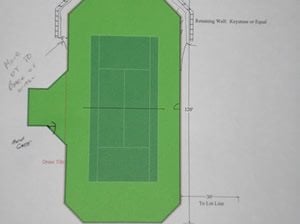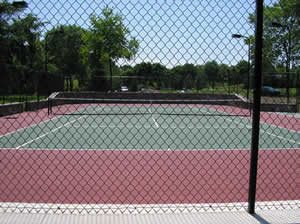- Concrete Tennis Court Home
- Concrete Tennis Court Cost
- Related Information
- Post-Tensioned Concrete
- Building Concrete Slabs
- Learn more about sport courts at LandscapingNetwork.com
The Concrete Tennis Court Advantage
Cost of Installing a Tennis Court
A well-constructed, properly maintained concrete court can provide decades of recreational enjoyment. But you'll have to pay to play. The cost of a regulation-size post-tensioned concrete tennis court with a cushioned surface can be double that of an equivalent asphalt court. "The basic asphalt court starts at about $40,000 to $45,000, with the average price probably in the mid $50s to low $60s. For a post-tensioned court, you'll pay in the low $100,000 range," says Kolkmann.
Your final tally for a play court depends on a number of variables, according to ASBA, including the condition and accessibility of the site, the type of surfacing system applied, and any accessories and amenities such as landscaping, fencing, a spectator area, and lighting for night play.
Although Kolkmann admits that concrete courts cost substantially more initially than asphalt, an asphalt surface often requires more frequent and costly upkeep over its lifespan to repair cracking and settling. "Through our own recordkeeping, we estimate that an asphalt court will be unavailable for play, due to repairs being made, for about 100 days over a 20-year period," he says. "During this same time, a post-tensioned slab would be down for about 20 days. In our climate in the upper Midwest, repairs can only be done in the summer, when everyone wants to play. For a private court, the downtime may not be as crucial. But for a club, it can be a substantial unknown cost in lost revenue."
If you're on a budget, there are ways you can cut back on your expenditure for a concrete court without compromising quality, such as opting for a hard court rather than cushioned surface or holding off on the installation of fencing and landscaping.
Advantages of a Concrete Tennis Court
What gives concrete the competitive edge? According to Fred Kolkmann, tennis and track division manager for Munson Inc., Glendale, Wis., concrete play courts are more durable, low maintenance, and crack resistant. Munson specializes in post-tensioned concrete and other types of play courts, and has won national and state awards for its concrete tennis court installations.
"The biggest drawback of asphalt courts is not that they crack, for even a post-tensioned slab may crack from shrinkage or even develop minor structural cracking, but that the cracks continue to widen year after year," says Kolkmann. "I have seen asphalt courts with cracks as wide as 2 to 3 inches, making them a hazard to the players. The advantage with a post-tensioned slab is that it will not allow the crack to widen, but will keep it compressed to a very thin line."
Kolkmann says that asphalt courts can also develop low areas over time due to settling of the soil or base under the asphalt surface. "With a post-tensioned slab, this area can be bridged and no settling will occur. In addition, concrete courts can often be installed on unstable soils where it would be cost-prohibitive to do extensive excavating and base work to support an asphalt court," he says.
Concrete Aces Asphalt in play Court Matchup
Post-tensioned concrete courts earn the trophy for durability, playability, and long-term value. Benefits include:
- Increased resistance to crack development
- Increased resistance to settling or heaving
- A more controlled slope for better drainage
- A more uniform playing surface
- Elimination of control joints
- Lower maintenance costs
- Longer service life






